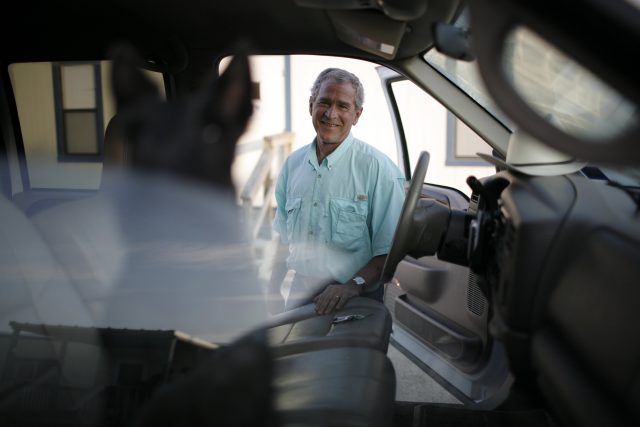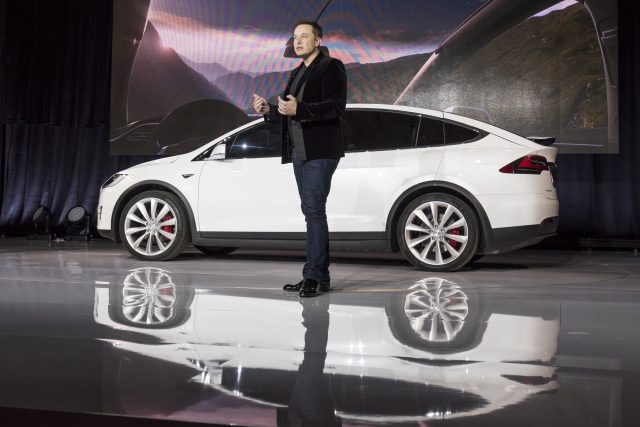The Arcimoto FUV slices through a wet Vegas parking lot, kicking up spray from puddles and smiles from passersby. Despite the unusual downpour, I stay bone dry under the electric tricycle's semi-enclosed canopy, twisting the throttle to zip back and forth with a grin on my face.
While taxis on the road beside me inch through traffic towards the annual CES trade show, the world's first Fun Utility Vehicle is living up to its name. It's nippier than a car, drier than a scooter, and easier to handle than a motorbike.
From the back seat, Arcimoto founder and CEO Mark Frohnmayer shares his dreams of turning this ultra-efficient (230mpg-equivalent) trike into the world's greenest rideshare vehicle. "Around 80 percent of taxi trips are just one passenger," he says. "In a world where all vehicles are autonomous and you can hit a button and jump in, it doesn't make sense that you'd be jumping into a seven-passenger 5000lb vehicle all by yourself."Although the FUV is enjoyably manual for now, Arcimoto is working with two unnamed technology partners to get a self-driving version on the roads later this year, just as soon as it begins mass production of the FUV at a new factory in Eugene, Oregon. "We've got 2,250 pre-orders to fulfil first, then we want to produce 10,000 vehicles in 2019 and beyond," says Frohnmayer.
To help scale up production at their current factory, and start work on a second, Arcimoto is about to submit an application for a loan from the Advanced Technology Vehicles Manufacturing (ATVM) program at the US Department of Energy (DOE). This Bush-era project is intended to support the production of fuel-efficient, next generation vehicles in the US with long, low-interest loans. Even in an era of Trumpian cuts and climate skepticism, ATVM retains over $16 billion of loan authority to distribute—at least until the White House succeeds in killing the program, as it hopes to do this year.
"We are a publicly traded company and have other avenues to capital," Frohnmayer tells me. "But in terms of building out our full financing package, it makes sense to have that support."
He had better not hold his breath. In nearly a decade of operation, the ATVM program has issued just five loans, and none at all since 2011. Some electric vehicle (EV) start-ups are still waiting for a decision on loan applications filed in 2009 and 2010. Despite being credited with saving tens of thousands of blue collar jobs in the American heartland and launching Tesla to its current heights, the ATVM remains mostly unknown to the public, unloved by politicians, and unable to complete any new loans.
So how did a program that was meant to embody America's high-tech future get so stuck in the past?

Sorry, Detroit
The big three US carmakers, Ford, GM and Chrysler, have traditionally had little incentive to build economical vehicles. With gas taxes in the US a fraction of those in most developed countries (about one tenth of those in the UK, for instance), Americans consistently choose large comfortable cars and powerful pickups over smaller, more efficient vehicles.
So when the Bush administration proposed more stringent fuel standards in 2007, Detroit faced a bigger bill than European and Japanese carmakers to bring fleets up to scratch. ATVM was the solution: a corporate welfare package of cheap money to help US-based automakers compete with fuel-sipping imports. The program authorized up to $25bn in very low interest loans to build or modernize American car plants, as long any vehicles they built achieved at least 25 percent higher fuel economy than comparable 2005 models.
ATVM went live in 2009, just as the Great Recession was freezing the banking system. The Big 3, scrambling for cash, saw it as a lifeline. Chrysler requested $8.5 billion in ATVM loans, Ford $11 billion and GM a whopping $14.4 billion.
"We were never going to be in a position to provide that size of a loan to a single entity," remembers Jonathan Silver, who was named Executive Director of the DOE's Loan Programs Office (LPO) in November 2009. "One of the ways to de-risk an investment portfolio is to ensure the risk is balanced. It's hard to do that if one investment is over half its value."
ATVM had simply arrived too late for GM and Chrysler, which slid into bankruptcy and restructuring. But Ford held on by the skin of its teeth, securing a $5.9 billion loan late in 2009 to upgrade factories across the midwest to produce hybrid vehicles and new efficiency technologies. Nissan North American got a $1.4 billion loan a few months later.
But the chaos of the recession masked a shift at the DOE. With arrival of Obama-appointee Silver, ATVM's focus changed overnight. Helping Detroit tweak its gas mileage would now take a back seat to ushering in a green transportation revolution.

Hey Elon
By the end of 2009, Elon Musk's EV startup Tesla had manufactured only a few hundred, hand-made Roadster sports cars. To build his next vehicle, the Model S sedan, Musk would need to completely refit an old Toyota-GM plant in California to build battery packs, motors and other components, quickly and at volume.
"With the credit market completely locked up, there was no place to get support," says James Chen, who worked at Tesla from 2010 to 2016, ending up as Vice President for Regulatory Affairs. "The ATVM loan program was a really good place for us."
"The risk profile at Tesla was certainly different to that at Ford and Nissan," says Silver. "But at the same time, the technology was radically different, and theoretically very important. I was trying to find technologies that could radically transform the nation's infrastructure and that could only get there with some kind of government support, which I took to be the mission of the organization."
In January 2010, just over a year from when it had first applied to ATVM, Tesla received a ten-year loan of $465 million to build the Model S. In April, another EV company, Fisker Automotive, got a $529 million ATVM loan to develop and produce a luxury plug-in hybrid sedan called the Karma at a plant in Delaware.
For Tesla, the loan provided credibility as much as capital. "Having the federal government, which obviously had to do its due diligence, provide that loan was instrumental in helping launch the company," says Chen. "It was a great validation of what Tesla was doing." Shortly after the loan, Toyota invested $50m in Tesla to work together on an electric SUV. The first Model S rolled off the production line at Tesla's new factory just over two years later. Tesla now has a stock market valuation higher than either Ford or the merged Fiat-Chrysler Automobile.
With Tesla and Fisker netting nearly a billion dollars between them, the EV community woke up to ATVM in a big way. By 2011, over 75 start-ups, suppliers and OEMs had applied for a total of around $50 billion. "We saw crazy ideas," says Silver. "We had inflatable cars and underwater cars, stuff that was never going to go anywhere." But there were also dozens of sensible, smart applications from companies that appeared to boast the same mix of entrepreneurship, practicality and sustainability as Tesla or Fisker.
Bright Automotive been founded by an ex-GM executive to develop a plug-in hybrid delivery vehicle. Carbon Motors was building the world's first purpose-built police car. Aptera had already demonstrated an ultra-efficient three-wheeled car built with high-tech composite materials, while Elio Motors' three-wheeler would cost less than $7,500. Local Motors wanted $24m to support a new open source, 3D-printed model of car production.
Aptera filed its ATVM application just a few weeks after Tesla in the fall of 2008. "We were hot on the heels of Tesla and Fisker, with Bright Automotive and a couple of others," remembers Paul Wilbur, Aptera's CEO. "We saw them getting their funding, and that's when we really started to think it was a viable funding mechanism for us."
In March 2011, one of these scrappy start-ups, Vehicle Production Group, even secured a modest $50m loan to produce a wheelchair-accessible vehicle powered by natural gas. But this would prove to be the last loan that ATVM ever completed.
In May 2011, the DOE froze Fisker's credit line after it missed key performance milestones. Fisker's battery supplier then recalled power packs and went bankrupt, while Hurricane Sandy destroyed over 300 Fisker Karmas at a port in New Jersey in 2012. The company filed for bankruptcy itself the next year, leaving the ATVM program with a net loss of $139 million.
Silver says, "The Fisker loan was done before I get there, where the Tesla loan was completed after we put some professionals in place. [But] from the very beginning, Henrik Fisker was developing a car, and Elon Musk was developing a car company. And those are two very different things."
The spectacular implosion of Fisker was compounded by the failure of Solyndra, a manufacturer of innovative photovoltaic solar panels that received a $535 million DOE loan guarantee in 2009 under a sister DOE program. However, Solyndra was unable to turn a profit and filed for Chapter 11 bankruptcy in September 2011.
Listing image by Lucid
Read Again https://arstechnica.com/cars/2018/03/trump-may-kill-the-federal-green-car-program-but-it-was-already-on-the-ropes/Bagikan Berita Ini















0 Response to "The loan program that buoyed Tesla, stalled out, and landed on Trump's cut list"
Post a Comment